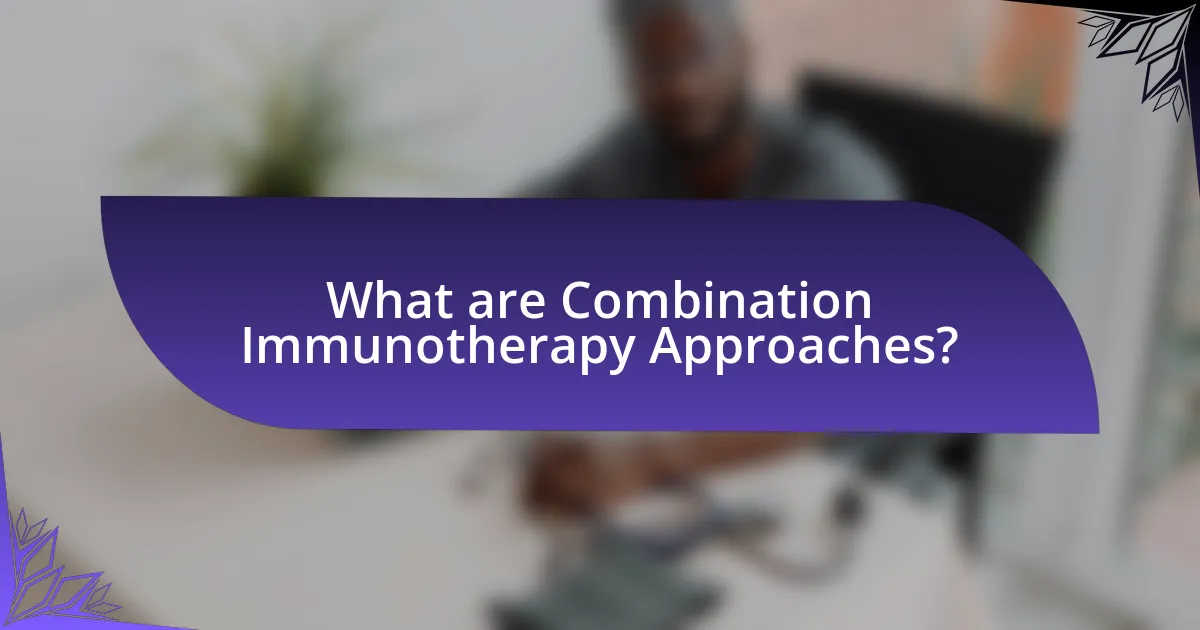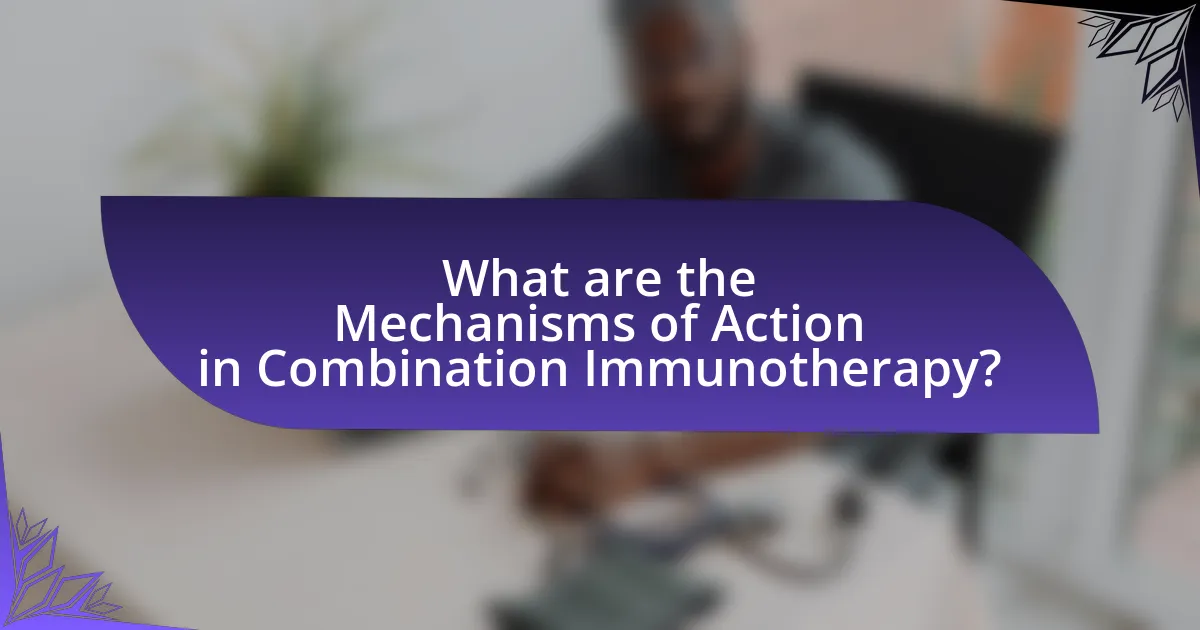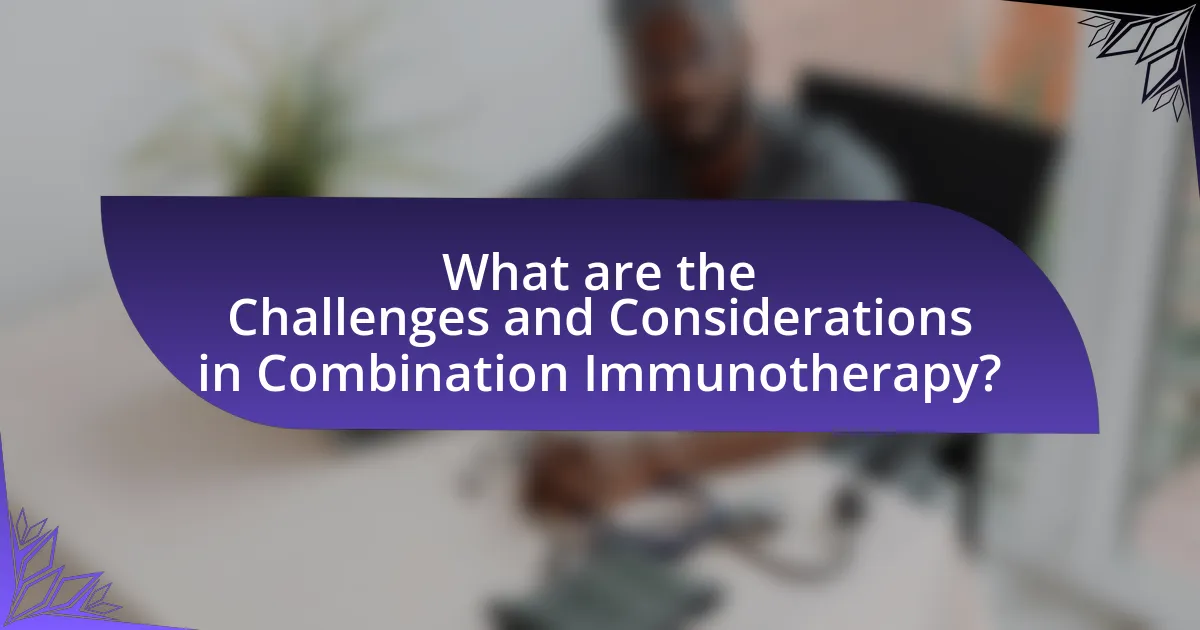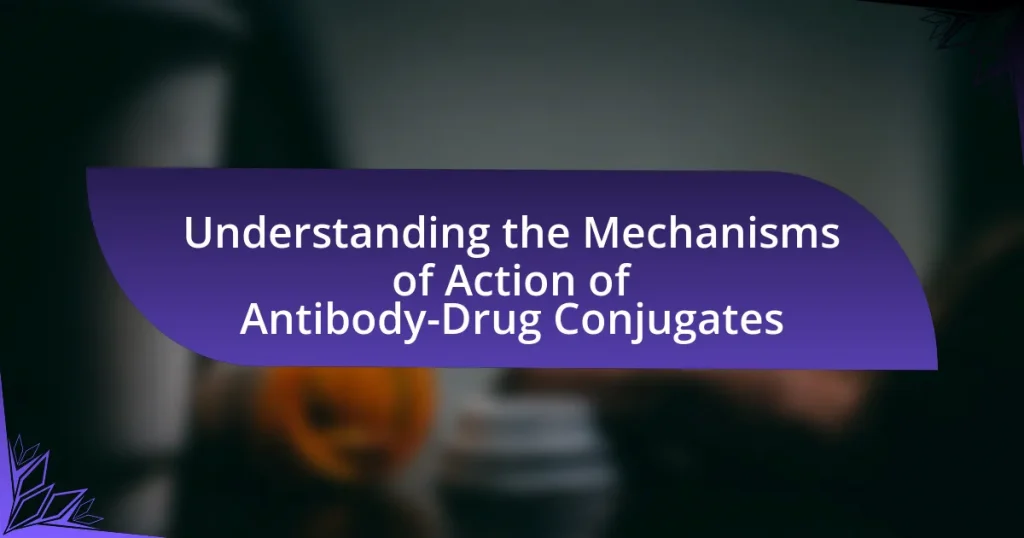Combination immunotherapy approaches are innovative cancer treatment strategies that utilize multiple immunotherapeutic agents to enhance the immune system’s ability to combat tumors. This article explores the mechanisms of action behind these approaches, highlighting how they differ from traditional therapies by targeting various pathways involved in tumor growth and immune evasion. Key components such as immune checkpoint inhibitors, cancer vaccines, and adoptive cell transfer therapies are examined, along with their synergistic effects that improve patient outcomes. Additionally, the article addresses the challenges, potential side effects, and the role of biomarkers in optimizing treatment regimens, providing a comprehensive overview of the current landscape in combination immunotherapy.

What are Combination Immunotherapy Approaches?
Combination immunotherapy approaches are treatment strategies that utilize two or more immunotherapeutic agents to enhance the immune system’s ability to fight cancer. These approaches aim to target multiple pathways involved in tumor growth and immune evasion, thereby improving treatment efficacy compared to single-agent therapies. For instance, combining immune checkpoint inhibitors with cancer vaccines has shown increased anti-tumor responses in clinical trials, demonstrating the potential for synergistic effects that can lead to better patient outcomes.
How do Combination Immunotherapy Approaches differ from traditional therapies?
Combination immunotherapy approaches differ from traditional therapies by utilizing multiple mechanisms to enhance the immune response against cancer, rather than relying on a single treatment modality. Traditional therapies, such as chemotherapy and radiation, primarily target cancer cells directly, often leading to significant side effects and limited specificity. In contrast, combination immunotherapy leverages the synergistic effects of different agents, such as immune checkpoint inhibitors and targeted therapies, to activate and expand the immune system’s ability to recognize and destroy tumors. This multifaceted approach has been shown to improve patient outcomes, as evidenced by clinical trials demonstrating higher response rates and prolonged survival in various cancers when using combination immunotherapy compared to traditional therapies alone.
What are the key components of Combination Immunotherapy Approaches?
The key components of Combination Immunotherapy Approaches include immune checkpoint inhibitors, cancer vaccines, and adoptive cell transfer therapies. Immune checkpoint inhibitors, such as anti-PD-1 and anti-CTLA-4 antibodies, enhance T-cell activation and proliferation, leading to improved anti-tumor responses. Cancer vaccines stimulate the immune system to recognize and attack cancer cells by presenting tumor-associated antigens. Adoptive cell transfer therapies involve the infusion of activated T cells, such as CAR T cells, which are engineered to target specific cancer antigens. These components work synergistically to enhance the overall efficacy of cancer treatment, as evidenced by clinical trials demonstrating improved patient outcomes when these therapies are combined.
Why is the combination of therapies important in immunotherapy?
The combination of therapies is important in immunotherapy because it enhances the overall effectiveness of treatment by targeting multiple pathways involved in tumor growth and immune evasion. This approach can lead to improved patient outcomes, as evidenced by studies showing that combination therapies, such as immune checkpoint inhibitors paired with targeted therapies or chemotherapy, can result in higher response rates and prolonged survival compared to monotherapy. For instance, the combination of nivolumab and ipilimumab has demonstrated significant efficacy in melanoma, with clinical trials indicating a 58% overall response rate compared to 11% for monotherapy. Thus, combining therapies addresses the complexity of cancer biology and helps overcome resistance mechanisms, making it a critical strategy in modern immunotherapy.
What are the main types of Combination Immunotherapy Approaches?
The main types of combination immunotherapy approaches include immune checkpoint inhibitors, cancer vaccines, and adoptive cell transfer. Immune checkpoint inhibitors, such as anti-PD-1 and anti-CTLA-4 antibodies, enhance T-cell responses against tumors. Cancer vaccines stimulate the immune system to recognize and attack cancer cells, while adoptive cell transfer involves the infusion of activated immune cells, like CAR T-cells, to target specific tumors. These approaches are often used in tandem to improve therapeutic efficacy and overcome resistance mechanisms in cancer treatment.
How do checkpoint inhibitors work in combination therapies?
Checkpoint inhibitors work in combination therapies by enhancing the immune system’s ability to recognize and attack cancer cells. These inhibitors block proteins that suppress immune responses, such as PD-1, PD-L1, and CTLA-4, thereby allowing T cells to remain active against tumors. For instance, when combined with other treatments like chemotherapy or targeted therapies, checkpoint inhibitors can lead to improved tumor response rates and overall survival in patients. Clinical studies have shown that combinations, such as nivolumab (a PD-1 inhibitor) with ipilimumab (a CTLA-4 inhibitor), can significantly increase the effectiveness of treatment in melanoma and other cancers, demonstrating the synergistic potential of these therapies.
What role do cytokines play in Combination Immunotherapy Approaches?
Cytokines play a crucial role in combination immunotherapy approaches by enhancing the immune response against tumors. They act as signaling molecules that facilitate communication between immune cells, promoting their activation, proliferation, and differentiation. For instance, cytokines like interleukin-2 (IL-2) and interferon-gamma (IFN-γ) can boost the activity of T cells and natural killer (NK) cells, leading to improved tumor cell destruction. Studies have shown that the inclusion of cytokines in combination therapies can lead to synergistic effects, increasing the overall efficacy of treatment regimens. For example, research published in the journal “Nature Reviews Cancer” highlights that combining checkpoint inhibitors with cytokine therapy can significantly enhance anti-tumor immunity, demonstrating the pivotal role of cytokines in optimizing therapeutic outcomes in cancer treatment.

What are the Mechanisms of Action in Combination Immunotherapy?
Combination immunotherapy employs multiple mechanisms of action to enhance the immune response against tumors. These mechanisms include the activation of different immune pathways, such as checkpoint inhibition, which blocks proteins that inhibit immune responses, thereby allowing T cells to attack cancer cells more effectively. Additionally, combination therapies can stimulate the production of immune effector cells, such as cytotoxic T lymphocytes and natural killer cells, which directly target and destroy tumor cells.
Furthermore, the use of multiple agents can lead to a synergistic effect, where the combined action of therapies results in a greater therapeutic effect than each agent alone. For example, combining immune checkpoint inhibitors with targeted therapies or chemotherapy can improve overall survival rates in various cancers, as evidenced by clinical trials showing enhanced efficacy in melanoma and lung cancer patients.
How do immune checkpoint inhibitors enhance anti-tumor responses?
Immune checkpoint inhibitors enhance anti-tumor responses by blocking proteins that inhibit T-cell activation, thereby allowing the immune system to recognize and attack cancer cells more effectively. These inhibitors, such as anti-PD-1 and anti-CTLA-4 antibodies, disrupt the inhibitory signals that tumors exploit to evade immune detection. For instance, studies have shown that the use of anti-PD-1 therapy in melanoma patients resulted in a significant increase in overall survival rates, demonstrating the effectiveness of these agents in promoting robust anti-tumor immunity.
What specific pathways are involved in immune checkpoint inhibition?
Immune checkpoint inhibition primarily involves the PD-1/PD-L1 and CTLA-4 pathways. The PD-1 pathway, when activated, inhibits T-cell activation and proliferation, while PD-L1, expressed on tumor cells, binds to PD-1, further suppressing immune responses. The CTLA-4 pathway functions by downregulating T-cell activation through competitive inhibition of CD28, which is essential for T-cell co-stimulation. These pathways are critical in the tumor microenvironment, where cancer cells exploit them to evade immune detection. Studies have shown that blocking these checkpoints can enhance anti-tumor immunity, leading to improved clinical outcomes in various cancers, as evidenced by the success of therapies targeting these pathways in clinical trials.
How does the timing of administration affect the efficacy of these inhibitors?
The timing of administration significantly influences the efficacy of inhibitors in combination immunotherapy approaches. Administering inhibitors at specific intervals can enhance their synergistic effects, leading to improved therapeutic outcomes. For instance, studies have shown that sequential administration of immune checkpoint inhibitors can optimize T-cell activation and proliferation, thereby increasing tumor response rates. Additionally, timing can affect the pharmacokinetics and pharmacodynamics of the drugs, as seen in research where the timing of anti-PD-1 and anti-CTLA-4 agents was critical for maximizing immune response against tumors. This evidence underscores the importance of strategic timing in the administration of inhibitors to achieve optimal efficacy in immunotherapy.
What is the role of T cell activation in Combination Immunotherapy?
T cell activation plays a crucial role in Combination Immunotherapy by enhancing the immune response against tumors. This process involves the stimulation of T cells, which are essential for recognizing and attacking cancer cells. In Combination Immunotherapy, agents such as immune checkpoint inhibitors and cytokines are used to promote T cell activation, leading to increased proliferation and cytotoxic activity against tumor cells. Studies have shown that activated T cells can produce cytokines like interferon-gamma, which further enhances the anti-tumor immune response, demonstrating the effectiveness of T cell activation in improving patient outcomes in cancer treatment.
How do different therapies synergize to activate T cells?
Different therapies synergize to activate T cells by combining mechanisms that enhance T cell recognition, proliferation, and effector function. For instance, immune checkpoint inhibitors, such as anti-PD-1 and anti-CTLA-4 antibodies, can remove inhibitory signals on T cells, thereby promoting their activation. When used alongside cancer vaccines that present tumor antigens, these therapies can increase the specificity and magnitude of the T cell response. Studies have shown that combination therapies can lead to improved clinical outcomes, as evidenced by clinical trials demonstrating enhanced tumor regression and prolonged survival in patients receiving both checkpoint inhibitors and vaccines compared to those receiving either treatment alone. This synergistic effect is attributed to the complementary pathways activated by each therapy, resulting in a more robust and sustained T cell response against tumors.
What are the implications of T cell memory in treatment outcomes?
T cell memory significantly enhances treatment outcomes by providing long-lasting immunity against previously encountered antigens. This memory allows for a more rapid and robust immune response upon re-exposure to the same pathogen or tumor cells, which is crucial in cancer immunotherapy. Studies have shown that patients with a strong T cell memory response exhibit improved survival rates and better responses to therapies, such as checkpoint inhibitors. For instance, research published in “Nature” by Chen et al. (2019) demonstrated that T cell memory correlates with durable responses in melanoma patients treated with combination immunotherapy, highlighting its critical role in achieving effective treatment outcomes.

What are the Challenges and Considerations in Combination Immunotherapy?
Combination immunotherapy faces several challenges and considerations, primarily related to safety, efficacy, and patient selection. The risk of increased toxicity arises from the synergistic effects of combining different immunotherapeutic agents, which can lead to severe immune-related adverse events. Additionally, determining the optimal dosing and scheduling of these therapies is complex, as interactions between agents can alter their effectiveness. Patient selection is critical; biomarkers must be identified to predict which patients will benefit from combination therapies, as not all patients respond similarly. Furthermore, the cost and accessibility of combination therapies pose significant barriers to widespread implementation. These challenges necessitate ongoing research to refine treatment protocols and improve patient outcomes in combination immunotherapy.
What are the potential side effects of Combination Immunotherapy Approaches?
Combination immunotherapy approaches can lead to a range of potential side effects, including immune-related adverse events such as colitis, dermatitis, hepatitis, and endocrinopathies. These side effects occur due to the enhanced activation of the immune system, which can mistakenly target healthy tissues alongside cancer cells. For instance, studies have shown that approximately 30-50% of patients receiving combination therapies experience some form of immune-related toxicity, with severe cases requiring immunosuppressive treatment to manage symptoms.
How can adverse effects be managed in patients undergoing treatment?
Adverse effects in patients undergoing treatment can be managed through proactive monitoring, dose adjustments, and supportive care interventions. Proactive monitoring involves regular assessments to identify side effects early, allowing for timely interventions. Dose adjustments can help mitigate severe reactions by modifying the treatment regimen based on individual tolerance levels. Supportive care interventions, such as administering medications to alleviate symptoms or providing psychological support, further enhance patient comfort and adherence to treatment. Studies have shown that implementing these strategies can significantly improve patient outcomes and quality of life during immunotherapy.
What factors influence the safety profile of combination therapies?
The safety profile of combination therapies is influenced by factors such as drug interactions, patient-specific characteristics, and the pharmacodynamics of the agents involved. Drug interactions can lead to increased toxicity or reduced efficacy, as seen in studies where certain combinations resulted in adverse effects not observed with monotherapy. Patient-specific characteristics, including age, genetic factors, and comorbidities, can alter how individuals respond to combination therapies, impacting safety. Additionally, the pharmacodynamics of the drugs, including their mechanisms of action and side effect profiles, play a crucial role in determining the overall safety of the combination. For instance, combining agents with overlapping toxicities can exacerbate adverse effects, while complementary mechanisms may enhance therapeutic outcomes without increasing risk.
How can biomarkers guide the use of Combination Immunotherapy?
Biomarkers can guide the use of combination immunotherapy by identifying patient-specific responses to treatment, thereby optimizing therapeutic strategies. For instance, biomarkers such as PD-L1 expression levels can predict the efficacy of immune checkpoint inhibitors, allowing clinicians to select appropriate combinations that enhance immune response. Studies have shown that patients with high PD-L1 expression benefit more from combination therapies involving anti-PD-1 and anti-CTLA-4 agents, leading to improved outcomes. Additionally, genomic profiling can reveal mutations that may influence treatment efficacy, enabling personalized approaches that maximize therapeutic benefits while minimizing adverse effects.
What types of biomarkers are most relevant for predicting treatment response?
The most relevant types of biomarkers for predicting treatment response in combination immunotherapy approaches include immune checkpoint inhibitors, tumor mutational burden (TMB), and PD-L1 expression levels. Immune checkpoint inhibitors, such as those targeting PD-1 and CTLA-4, have shown efficacy in enhancing T-cell responses against tumors, making their expression levels critical for assessing potential treatment outcomes. Tumor mutational burden serves as a quantitative measure of mutations within the tumor genome, with higher TMB correlating with better responses to immunotherapy, as evidenced by studies indicating that patients with high TMB have improved survival rates. Additionally, PD-L1 expression levels on tumor cells are often used as a predictive biomarker, with higher levels associated with increased likelihood of response to PD-1/PD-L1 inhibitors, supported by clinical trial data demonstrating improved efficacy in patients with elevated PD-L1 expression.
How can personalized medicine enhance the effectiveness of Combination Immunotherapy?
Personalized medicine can enhance the effectiveness of combination immunotherapy by tailoring treatment strategies based on individual patient characteristics, such as genetic profiles and tumor microenvironments. This approach allows for the selection of specific immunotherapeutic agents that are more likely to elicit a robust immune response in a given patient, thereby improving therapeutic outcomes. For instance, studies have shown that patients with specific biomarkers, like PD-L1 expression, respond better to certain immune checkpoint inhibitors when combined with other therapies, leading to increased survival rates. By integrating genomic data and other personalized factors, clinicians can optimize treatment regimens, minimize adverse effects, and ultimately increase the overall efficacy of combination immunotherapy.
What are best practices for implementing Combination Immunotherapy?
Best practices for implementing Combination Immunotherapy include selecting appropriate drug combinations based on their mechanisms of action, optimizing dosing schedules to enhance synergistic effects, and closely monitoring patient responses for adverse effects. Research indicates that combining immune checkpoint inhibitors with other modalities, such as targeted therapies or chemotherapy, can improve treatment outcomes in various cancers. For instance, studies have shown that the combination of nivolumab and ipilimumab leads to higher response rates in melanoma patients compared to monotherapy. Additionally, personalized treatment plans that consider individual patient characteristics and tumor microenvironments are essential for maximizing efficacy and minimizing toxicity.
How should treatment regimens be designed for optimal outcomes?
Treatment regimens should be designed based on a thorough understanding of the specific mechanisms of action of combination immunotherapy approaches to achieve optimal outcomes. This involves selecting agents that target different pathways to enhance the immune response against tumors, such as combining immune checkpoint inhibitors with cytokines or targeted therapies. Research indicates that such combinations can lead to synergistic effects, improving overall efficacy; for instance, a study published in the Journal of Clinical Oncology demonstrated that combining nivolumab and ipilimumab resulted in higher response rates in melanoma patients compared to monotherapy. Therefore, careful consideration of drug interactions, patient-specific factors, and the biological characteristics of the tumor is essential for maximizing treatment effectiveness.
What monitoring strategies are essential during Combination Immunotherapy?
Essential monitoring strategies during Combination Immunotherapy include regular assessment of immune-related adverse events, evaluation of tumor response through imaging studies, and monitoring of biomarkers indicative of immune activation. These strategies are crucial as they help identify potential toxicities early, assess the effectiveness of the treatment, and guide further therapeutic decisions. For instance, immune-related adverse events can occur in up to 70% of patients receiving combination therapies, necessitating vigilant monitoring to manage these complications effectively. Additionally, imaging studies such as CT or MRI scans are typically performed every 8 to 12 weeks to evaluate tumor response, while biomarkers like PD-L1 expression and circulating tumor DNA can provide insights into the immune response and treatment efficacy.



